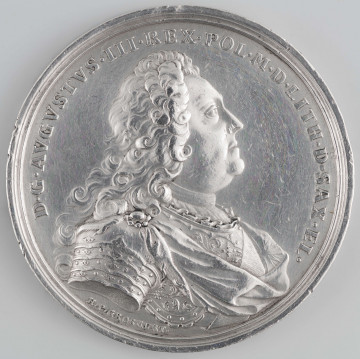
Enlargement of the Polish Army and erection of the statue of John III Sobieski
1789
National Museum in Lublin
Part of the collection: Polish medallic art.
Since the reform of the Holy Roman Empire by Charles IV of Luxembourg (1355-1378), the Emperor was succeeded during an interregnum by two Vicars of the Reich, the Duke of Saxony and the Palatine of Rhine, who administered the state in their respective territories. This dignity fell twice to the Elector of Saxony, Frederick August II, who as August III (1733-1763) was also King of Poland. The first time was after the death of Charles VI of Habsburg in 1740, and the second in 1745, after the death of Charles VII of Witettelsbach. These events were commemorated by, among others, occasional coins, hence called ‘Varangian’, and medals, which added splendour to the person of the Saxon Elector and his court.
The obverse of the medal in question is decorated with an equestrian portrait of Friedrich August II, crowned, sword in hand, in armour, with the elector's cloak draped over it. The representation is surrounded by an inscription in Latin, written in abbreviated form on account of the extensive monarchical titulary: D G FRID AUG R P D S AM & EL IN PROV IUR SAX PROVISOR ET VICARIUS: By God's grace, Frederick Augustus King of Poland, Duke of Saxony, Grand Marshal and Elector, in the provinces of Saxon sovereignty, provisional administrator of the Empire and Vicar. On the reverse side there is a crowned eagle with its head turned to the left, with spread wings and a sword in its right paw. On its breast there is a crowned Polish-Saxon coat of arms. The representation is completed by Latin inscriptions; at the top in an arch – DECUS ET PRAESIDIUM – and at the bottom – PROVISOR IMPERII ITERUM MDCCXLV translated respectively: Glory and defence and Re-administrator of the Empire 1745.
Signature on obverse: WERMUTH.F[ecit] indicates that the medal of interest was made in Saxony at the workshop of Christian Sigismund Wermuth (1711-1791). He inherited from his father Christian (1661-1739) a large, prosperous family medal-making business, from which over one thousand three hundred medals came out over several decades. In addition to his business, Christian Sigismund Wermuth took over from his father as court medal-maker at the Saxon court in Dresden. The style of his works, which were very popular in Poland at that time, is on the borderline between Baroque and Rococo.
Tomasz Markiewicz
Author / creator
Dimensions
cały obiekt: width: 53 mm
Object type
medal
Technique
stamp minting
Material
copper
Creation time / dating
Creation / finding place
Owner
The National Museum in Lublin
Identification number
Location / status

1789
National Museum in Lublin

1734
National Museum in Lublin

1730
National Museum in Lublin
DISCOVER this TOPIC
National Museum in Lublin
DISCOVER this PATH
Educational path